Dead Weight Analysis - Animal Profit and Loss, Purchase Prices, Sale Prices and On Farm Performance
Dead Weight Analysis is a analysis view of cattle or sheep data designed to allow the identification of individual animal performance whilst on the farm.
There is obviously more to take into account when looking at overall amount an animal makes or looses than just the sale price and purchase price. Though these two figures are a good start.
'VET and Med' and Feed can be directly applied to individuals, however feed cost's specifically can be difficult to atrribure to an individual. Feed costs are directly proportional to the days an amianal spends on the farm.
Other costs for example labour costs of stockman, water, electricity etc may be difficult to attribute to a specific animal, but may be estimated. Dead weight analysis brings all the data together for in depth analysis and has many columns from purchase to slaughter.
Getting Started - Selecting the Animals
From the cattle or sheep menu select 'Analysis' - 'Dead Weight Analysis' this will open the blank analysis view. Then click the 'Select Modify Animals' button at the top. Select animals sold or slaughtered within a date range.
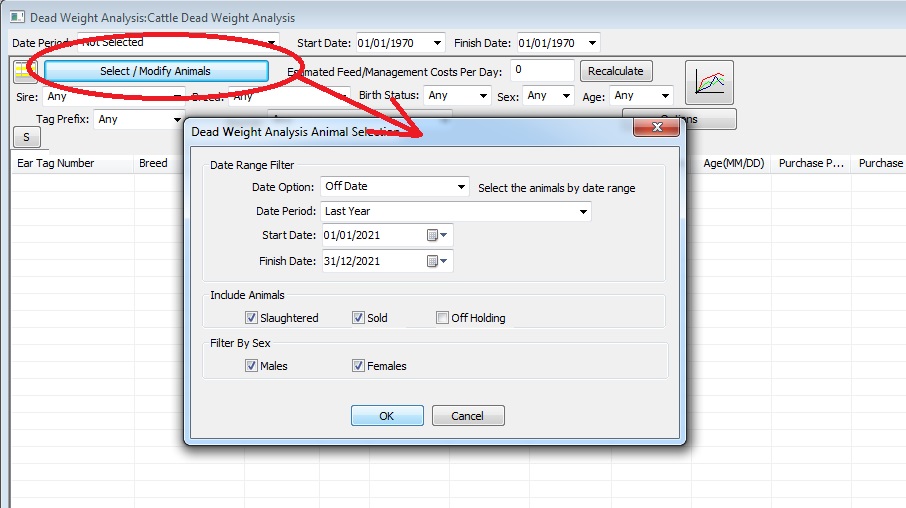
The report will then populate with animals sold or slaughtered within the period.

Purchase and Sale Prices
Purchase and sales prices may be entered for each individual animal, for example when the animals are purchased via a movement on. The prices are displayed on the analysis and a gross margin calculated, i.e Sale Price - Purchase Price.
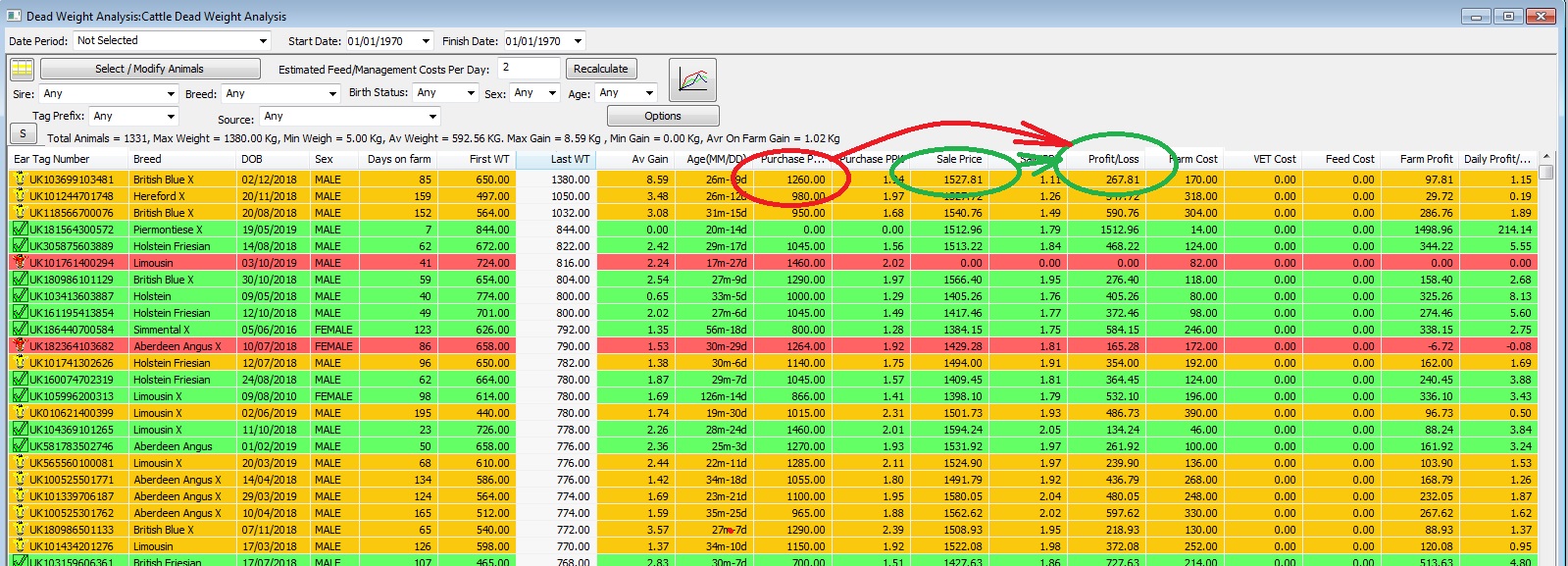
Vet and Med, Feed Costs and Estimated Daily Costs
Vet and Med and Feed cost can be applied to treatment and feeding records, although treatment record are easy, feed records can be time consuming as rations may change daily and managements group vary. For that reason and to enable us to apply other costs, a estimated daily cost can be used in the calculations.
This makes much more sense as we can include labour costs, water and electrical costs in the estimated daily figure. The cost of an animal on farm may be estitmated by using this figure and the days the animal spends on farm

Days On Farm
We generally know the date the animal arrives on the farm and the date the animal leaves the farm. Given we are fattening most then the date the animal leaves is dictated by its weight and condition, however some animal are retained past this for other reasons such as Farm Assurrance or sale price per kilo. Therefore we can calculate the days on farm and using the estimated daily cost arrive on a cost for the animal whilst on the farm.
Farm Profit and Daily Profit/Loss
Once we have a gross marging , sale price - purchase price we can apply the of the costs, vet and med, feed and farm Costs (estimated daily cost) to arrive at a 'Farm Profit/ loss'. This gives us a figure we can then divide by the days on farm to get a daily profit or loss. i.e whether the animal is making moeny or lossing money on a daily basis.

Column Options
The analysis view include a large number of columns, but it is unlikely you will want all of them. You can choose which columns to hide or display by clicking on the columns options button in the left corner. Details of the columns are the displayed. Tick those you want to display.
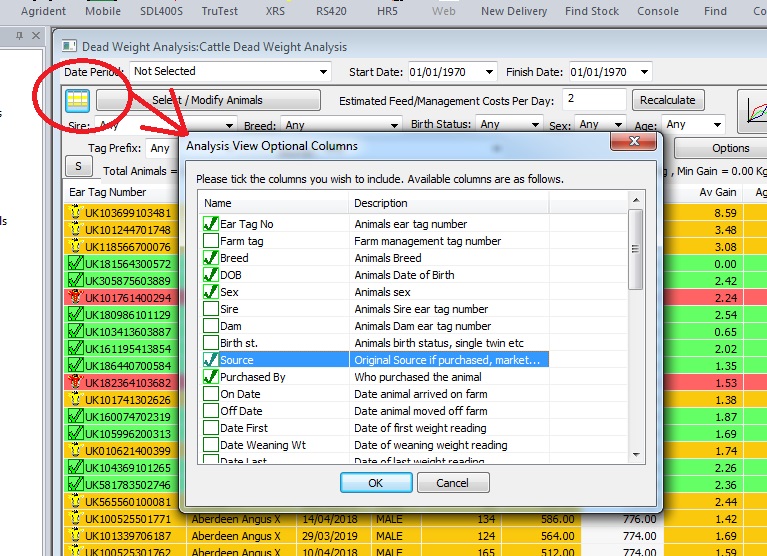
Weights and Weight Gain
Profit and loss actually works irrespective of the weights of the animal, however we would expect you to weigh the animal when it first arrives, and get a final on farm live weight before it leaves or is sent to slaughter. This gives us the average gain on farm. We can also record the 'SH Dead Wt' slaughter house dead weight, but given this is not directly comparable to the live weight it can not be used to calculate the on farm gain. It is however used to calculate the killing out percentage. It is therefore important that the final on farm weight is recorded with days proir to the movement, not 3 weeks before!
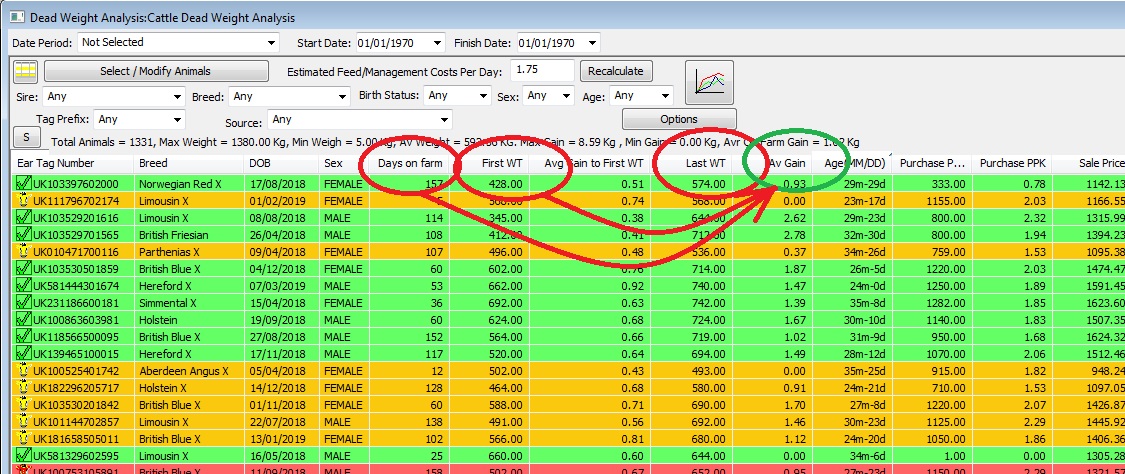
Daily live weight gain can be very important for most of us who are fattening store cattle or lambs, and not simply trading them based on Farm Assurance. If for example you are simply trading the cattle, Buying unassured and selling Assured, then the weight gain may well be unimportant or less important than the fact that the animal has been on farm 90 days. However for most of us daily llive weighht gain is the production of meat and meat is what we are selling. We can therefore directly compare the weight gain to the daily cost and the daily profit or lost. Based on the price of meat per kilo and an aproximate killing out percentage of 50% we can arrive at a required daily live weight gain in order to remain profitable.
Example for beef
Given a PPK for beef of £4 dead weight
A killing out percentage of 50% - give us £2 per Killo Live weight
If the animal is growing at 1 Kilo a Day, he is producing £2 a day in meat
If our estimated cost per day are £1.75 we are 26p a day in profit, if our costs are £2.25 we are losing 25 pence a day.
What is good gain and What should I expect
We would all expect our stock to be putting on weight, lossing weight is not the aim after all. But how much, there is no clear answer but we would expect a steer to be growing at above 1 kilo a day. More important however is that the growth rate is not below the daily cost of the feed and other farm costs.
It is obviously not good to be feeding a ration costing £3.75 per head if an animal is only growing at 500 grams a day, you will be loosing £ssss per day
But what about the performance of a store animal before it arrived? 'Average Gain To First Wt'
Average Gain To First Weight
The start the animal gets in life does effect how fast it grows later. For most cattle we know the date of birth and can therefore get an estimate of it's daily life weight gain up to the day it arrived on your farm, assuming you weigh it when it arrives. This figure is displayed in the analysis, but is really only applicable to stores.
If you are buying and selling store cattle, then it is not too complicated to understand that the cheaper the animal the more potential for profit. Given we tend to buy on weight therefore the cheaper animals will be the lighter ones, possible younger, but require more growth and more time on farm. Again critcal that they are growing to spec. So the growth before it arrives can be good to know and usefull in identifying poor performers. Animals that have been growing well tend to continue to do so.
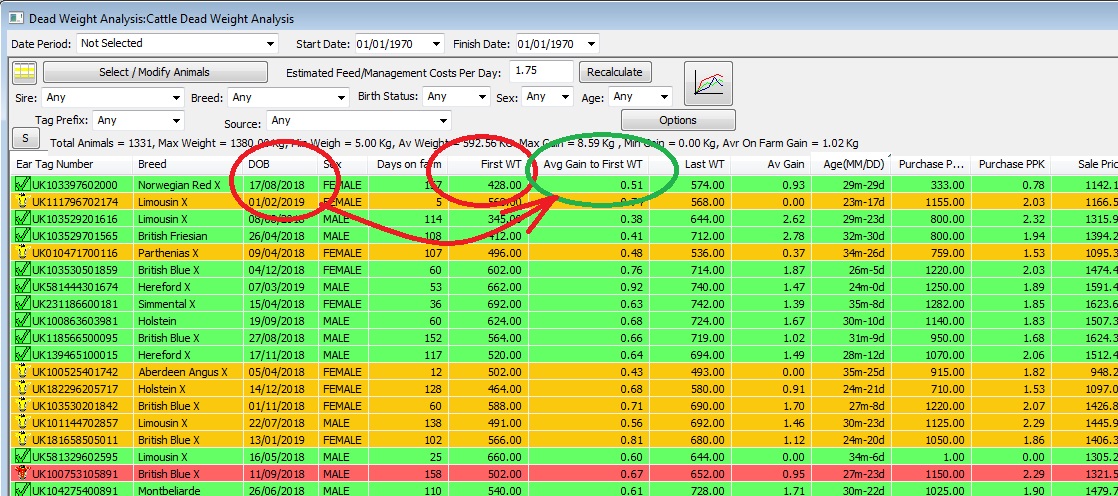
Slaughter House Dead Weights, Confirmation and Grades
If you enter slaughter house reports then dead weight, confirmation and grades are including in the analysis, and may be usefull when looking at why an animal did not get the expected price.

Purchase PPK and Sales PPK
The columns are calculates from the purchase price and first weight, and sale price and last weight. They therefore may not reflect the price per kilo at the market, or slaughter how. They are calculated in order to allow a direct comparison.

Colour Options, Reds, Amber and Green
The record in the analysis may be coloured based on the Fram Profit, Farm Daily Profit, Days On Farm or Weight Gain. Green above a target level, Red below a minimum level and amber in the middle. So we can display profit making animals in green, break even animals in Amber and loss making animals in RED.
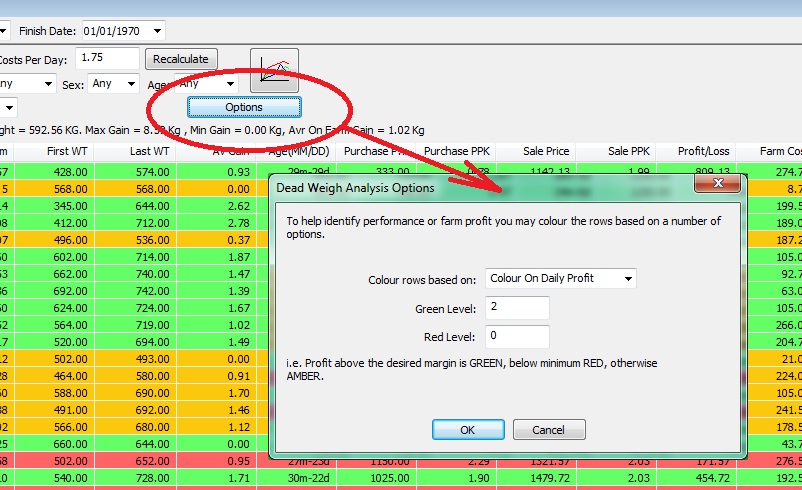
Recalculating Based on Estimated Costs
If you use the estimated daily cost in order to calculate profit and loss you may adjust the cost to establish your break even and profit point.
Set the estimated profit to £0 a day, press recalculate! hopefully most of your animals are profitable! No red ones( you sold these for less than you purchased them! )

Now change the estimated cost to £2 a day, hopefully most are still profitable! mostly in the green but possible some RED ( these cost your money !)
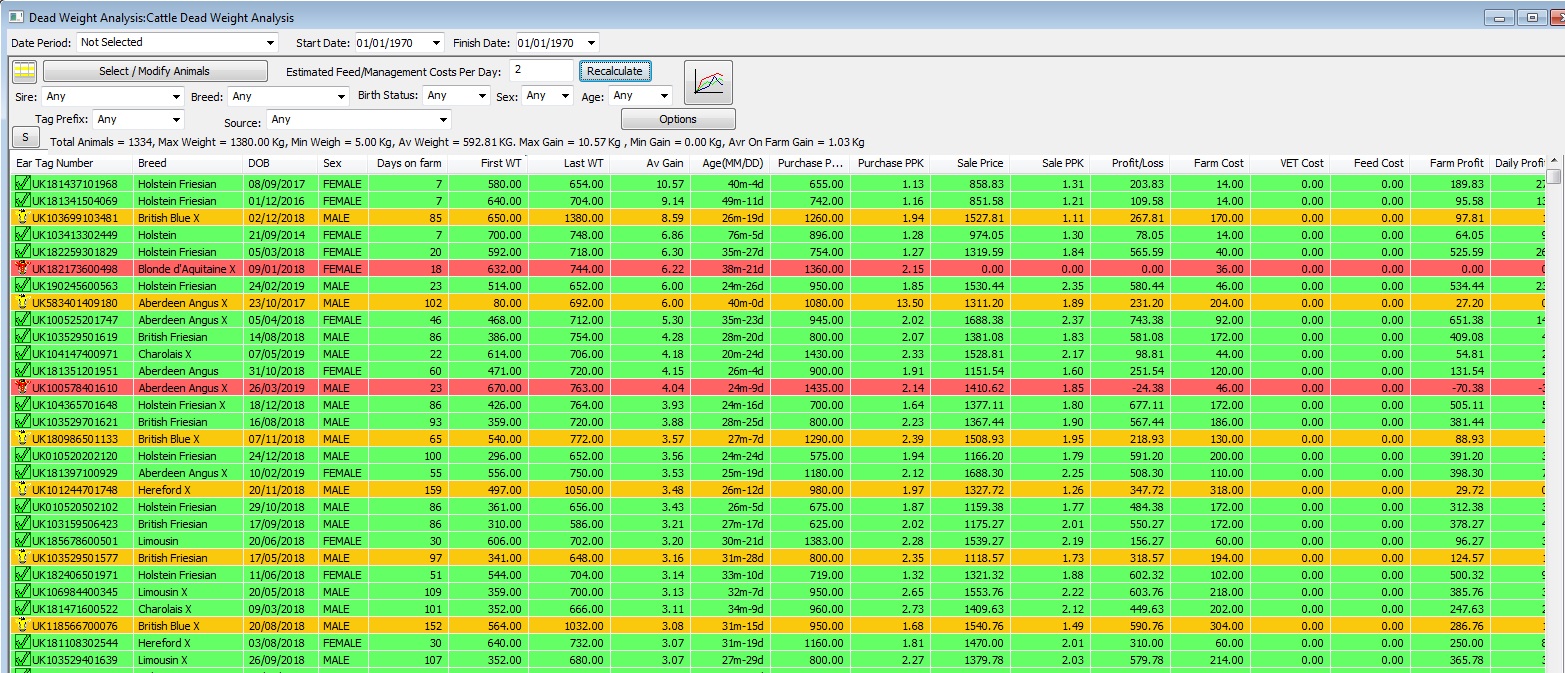
Now change the estimated cost to £4 a day, Very costly most animal will be Amber or RED and only an exceptional Green one

You may therefore explorer the effect of raising or lowering your daily costs.
Statistics
The analysis view lists every animal individualy, sometimes however a summary is better than the detail. These stats button in the left corner displays the statistics for the numeric columns.
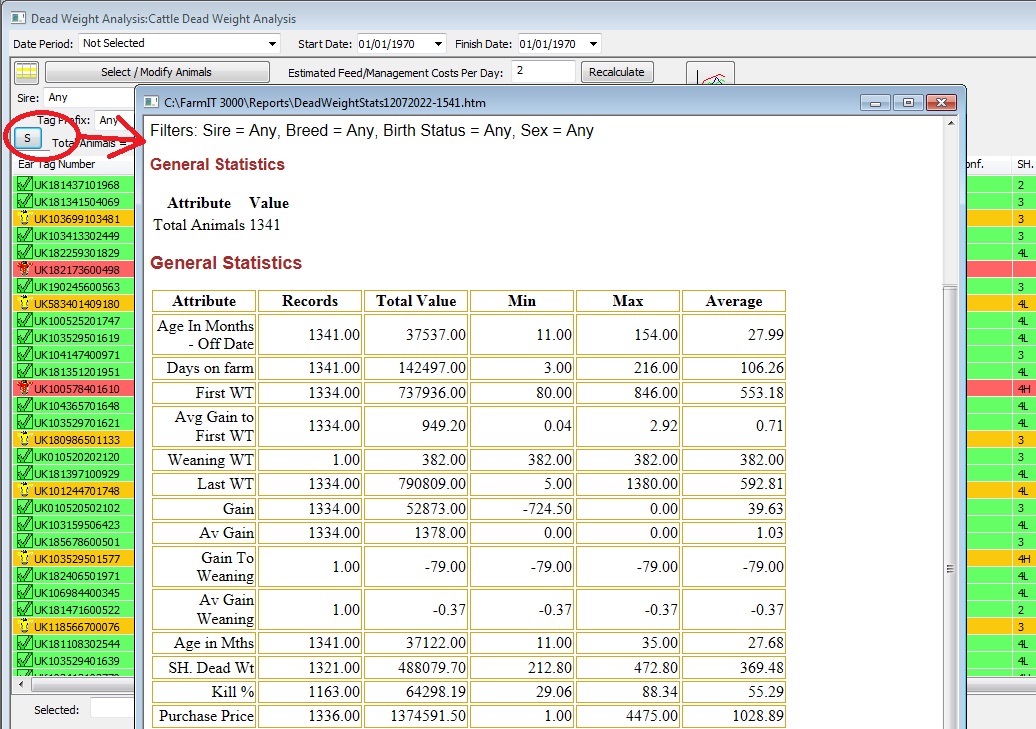
Exporting the Data
Like all the FarmIT 3000 reports and analysis views, the data in the dead weight analysis view may be exported to excell or a basic csv file by using the export functions under the main file menu.
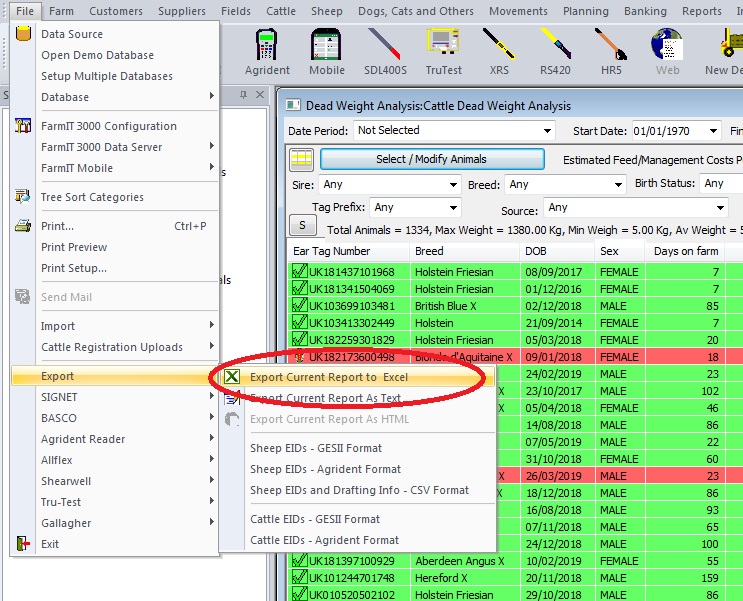
If Microsoft Excel is installed on the computer, it will be opened and the data transfered into the spreadsheet. If it is NOT installed you will get an error!. The data may be exported to a text file in a CSV format.
Making A Profit or A Loss
It is unlikely that every animal you buy will make a profit, the animal may also die on your farm resulting in a total loss. Dead weight analysis only shows the ones you sell!. Margins are also small, in fact the most important thing to control is your purchase price. Sales prices may go up or down and there can be little point in trying to speculate given things are out of your control.
The most overiding factor if you are feeding your animals with a set diet is simply the days on farm. Animals that are not growing should be slaughtered asap unless there is a clear and understandable problem. If you fatten your cattle on grass, YES you can have lower costs, or at least there are more hidden costs other than the feed bill. But remember there is still a cost.
Achieving good daily live weight gain with a minimal of cost is the aim. Weigh your animals regularly and be prepared to shift the under performers. If all are under performing check your feeding. water and environment, they are expected to grow!